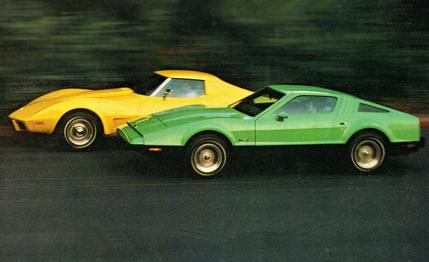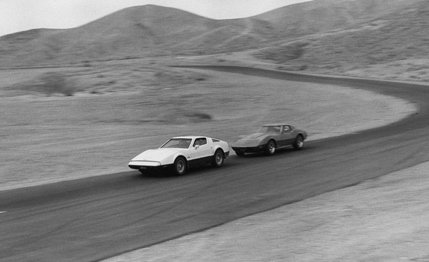 Comparison Tests
Comparison Tests
Willow Springs Raceway wanders across the desert floor and slithers up foothills of California's Soledad Mountain as if a passing glacier long ago had snagged the asphalt ribbon and towed part of the course up the slopes. Turn Six's descending corkscrew is Willow's equalizer. The Corvette is on its tiptoes diving downward, darting from left to right, its tail yawing sideways under light braking. The Bricklin seizes the opportunity to close the gap — it has the advantage of stability with soft understeer through the switchback and can brake aggressively right up to the pavement's edge. Delayed by the corrections its driver is forced to make, the Corvette is late turning on the power as it exits onto the straight. Accelerating down the flattening grade, the Chevy gradually recaptures the advantage from the charging Bricklin, and the gap widens on the long back straightaway. By the start/finish line, the interval between the cars has grown to just under two seconds (on a 1:54 lap), a symbolic performance separation that was to hold throughout Car and Driver's test of the original U.S. sports car and the Canadian-made challenger hot on its heels.
Vast financial investments, a loudly publicized New Brunswick assembly plant and an artful promotional effort have finally produced a tangible threat to the Corvette. Skeptics be damned; the Bricklin lives. With two contenders eyeing the same turf, a championship bout is the inevitable test. So we took to a few California and Arizona highways, Willow Springs and Irwindale Raceways and the testing laboratories of Automotive Environmental Systems to sort out a winner.

The gull-winged protagonist is Bricklin Number 781, the very first 1975 model off the New Brunswick assembly line. Unlike all 780 of its 1974-model forebears, this Bricklin is powered by a 351-cubic inch Ford Windsor V-8 instead of an AMC 360 engine. The current season's output will also be massaged with a host of other detail refinements inevitable in an automobile struggling through its infancy. Most important among them is the deletion of a four-speed manual transmission choice. Malcolm Bricklin has deemed it not in keeping with his car's safety image, so the Ford-made "C-4 Cruise-o-matic" is the only transmission currently specified. Another "detail" change: What started out as a $3500 idea has become a "fully-equipped" reality at $9780.
In the incumbent's corner we have the thoroughly experienced Corvette Stingray. It too has shed an important option for 1975: the big-block 454-cu. in. engine. Only two versions of the 350-cu. in. small block V-8 remain, both exhaling through a single catalytic converter. Our test car was built with the base 165-horsepower (net) engine because the optional 205-hp L82 engine had not been released at the time of this comparison. Wherever possible, we chose options for the Corvette to match it to the Bricklin, including a Turbo-Hydramatic transmission (mandatory in California), boosting the base $6810 Corvette up to a $8352 machine.
They come off amazingly close, these two American GT coupes. As long as you focus on the performance readout, they are practically identical. Whether it's regulatory strictures, market pressures or economic demands that have squeezed both cars down to a comparatively mediocre but remarkably similar level doesn't really matter. Stand on the gas and both machines will deliver you to the end of the quarter-mile within half a second of each other. They both corner within 0.01 G of each other and even deliver fuel economy within a half mpg during every phase of the C/D Mileage Cycle. On paper, they're almost interchangeable — with the Corvette enjoying a small performance edge. But live with them and they become completely different cars. Each has a character so individual that you know immediately if your mount came from St. Louis or New Brunswick.